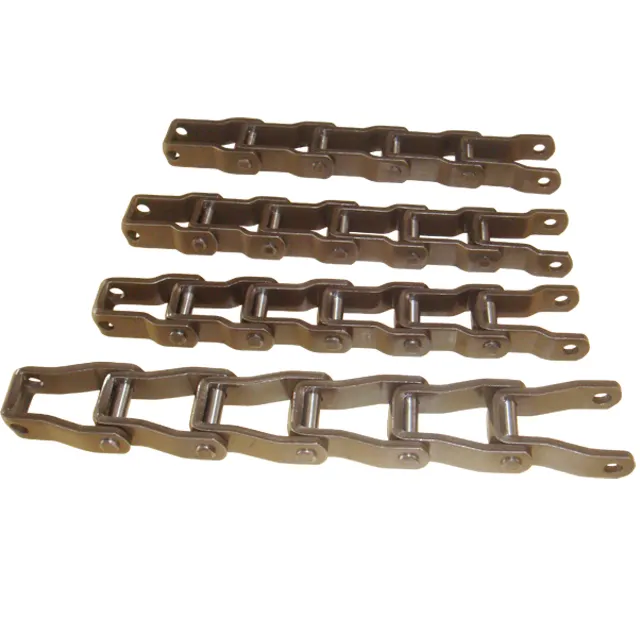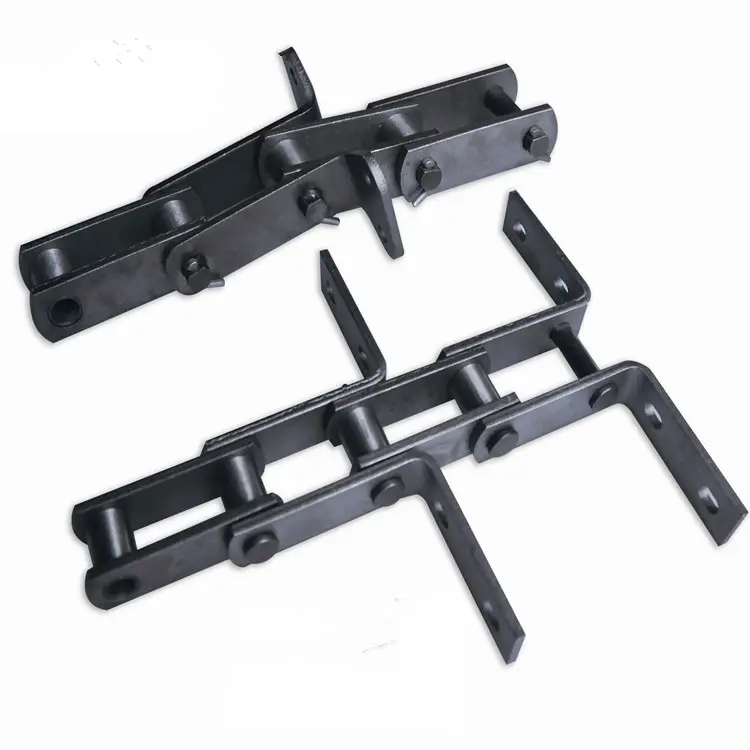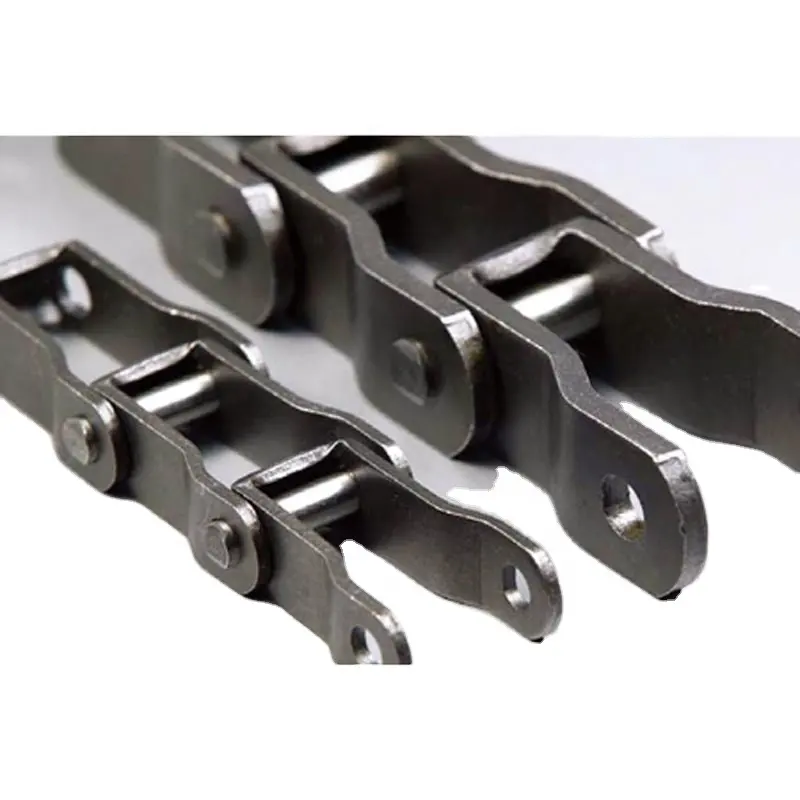Product Description
D667k Steel Pintle Chain
Products are made of high quality alloy steel production. The plates are punched and squeezed bores by precision technology. The pin, bush, roller are machined by high-efficiency automatic equipment and automatic grinding equipment, then through heat treatment of carburization, carbon and nitrogen protection mesh belt furnace, surface blasting process etc. Assembled precision by Internal hole position, spin riveted by pressure to ensure the performance of the entire chain.
Specifications
| Technique Treatment | |||
| 1 | Shot Peening | 8 | Tempering |
| 2 | Bluing | 9 | Oiling |
| 3 | Nickel-plated | 10 | Greasing |
| 4 | Zincing | 11 | Special color |
| 5 | Heat Treatment | 12 | Stain proofing |
| 6 | Carburizing | 13 | Pre-stretched and anti-fatigue |
| 7 | Quenching | ||
Our Service
1. Any of your kind inquiry conveyor chain would be replied within 24 hours.
2. Well-trained and experienced sales staffs will reply all your concerns in fluent English.
3. OEM services are available with us, our professional designer would make your private idea into being.
4. Protection of your sales area, ideas of design and all your private information.
5. Delivery by air mail or ship for your orders.
Why choose us
1. We are the manufacture.
2. We have near 30 years experience of making chains and chain links.
3. Our design team has extensive experience in the chain design.
4. Best service and prompt delivery.
5. We offer various styles, size and colors to meet your requirement.
6. We covering a production area of 18750 square CHINAMFG have more than 100 employees and we have a complete set of testing equipment to ensure our quality.
| Usage: | Conveyor Chain |
|---|---|
| Material: | Alloy |
| Surface Treatment: | Polishing/Electroplating/Oxygenation |
| Feature: | Oil Resistant |
| Chain Size: | Wh124 |
| Structure: | Conveyor Chain |
| Samples: |
US$ 0/Piece
1 Piece(Min.Order) | |
|---|
| Customization: |
Available
| Customized Request |
|---|

What are the noise and vibration characteristics of pintle chains?
Pintle chains generally exhibit low noise and vibration characteristics when properly maintained and operated within their recommended specifications. Here’s a detailed explanation of their noise and vibration characteristics:
Noise Characteristics:
Pintle chains are designed with interlocking link plates and pins, which help reduce noise during operation. The engagement between the chain and the sprockets is smooth, minimizing the impact and noise generation. Additionally, the use of suitable lubrication can further reduce noise levels.
However, it’s important to note that improper maintenance, such as lack of lubrication or worn-out components, can lead to increased noise levels. Regular inspection, lubrication, and replacement of worn parts are essential to keep noise levels in check.
Vibration Characteristics:
Pintle chains generally transmit minimal vibration during operation. The precision engineering and smooth movement of the chain components contribute to reduced vibration. Additionally, the use of high-quality materials and well-maintained chain systems can further minimize vibration.
Excessive vibration in pintle chains can occur if the chain is misaligned, worn, or not tensioned correctly. Regular maintenance and alignment checks are necessary to ensure optimal performance and to prevent increased vibration levels.
Applications:
Pintle chains with low noise and vibration characteristics are suitable for various industries, including material handling, forestry, agriculture, and more. In applications where noise reduction is crucial, such as in indoor environments or noise-sensitive areas, proper chain maintenance and lubrication become even more important.
Overall, pintle chains are known for their relatively quiet and smooth operation when maintained properly. Ensuring correct installation, adequate lubrication, and regular maintenance will help to maintain the desired noise and vibration characteristics, promoting efficient and reliable chain performance.

What are the environmental considerations when using pintle chains?
Pintle chains, like any other industrial equipment, have certain environmental considerations that should be taken into account to ensure their proper functioning and longevity. These considerations include:
- Corrosion Resistance: In outdoor or humid environments, pintle chains should be made from materials that offer good corrosion resistance, such as stainless steel or coated chains. This helps prevent rust and corrosion, extending the chain’s lifespan and maintaining its performance.
- Lubrication: Proper lubrication is essential to reduce friction and wear between the chain components. Using the appropriate lubricant helps minimize the environmental impact and ensures the chain operates smoothly and efficiently.
- Contamination Control: In dusty or dirty environments, pintle chains may accumulate debris and contaminants. Implementing proper seals, covers, or guards can help protect the chain from contamination, leading to improved performance and reduced maintenance needs.
- Temperature: Pintle chains used in extreme temperature conditions should be made from materials that can withstand high or low temperatures without compromising their strength and flexibility.
- Chemical Exposure: In industries where pintle chains come into contact with chemicals, it is essential to select materials that can resist chemical exposure and prevent chain degradation.
- Waste Management: Proper waste management practices should be implemented for old or worn-out pintle chains to reduce their environmental impact. Recycling or disposing of old chains responsibly can be beneficial for the environment.
By considering these environmental factors, industries can ensure that pintle chains are used effectively and sustainably in their applications. Proper maintenance, material selection, and lubrication are essential aspects of maintaining a pintle chain’s performance while minimizing its impact on the environment.

How do you select the right size and strength for a pintle chain?
Selecting the right size and strength for a pintle chain involves considering several factors to ensure optimal performance and longevity. Here’s a more detailed explanation of the selection process:
- Load Requirements: Determine the maximum load the pintle chain will need to carry. This includes both static and dynamic loads. Consider the weight of the conveyed material or the tension in the system for power transmission applications.
- Pitch Size: Measure the distance between each pintle pin center to the next. This measurement is known as the pitch size. Choose a pintle chain with a pitch size that matches the sprocket’s pitch diameter to ensure proper engagement and smooth operation.
- Chain Strength: Based on the calculated maximum load, select a pintle chain with adequate tensile strength to handle the load without risking chain failure or deformation. Consult the chain manufacturer’s documentation for strength ratings and specifications.
- Number of Strands: For applications requiring higher load capacities, you may need to use multiple strands of pintle chains. Determine the number of strands based on the load distribution required for the specific application.
- Environmental Factors: Consider the operating environment of the pintle chain. If the chain will be exposed to corrosive substances, moisture, or extreme temperatures, choose a material that provides suitable resistance to these environmental factors (e.g., stainless steel for corrosion resistance).
- Speed: Evaluate the speed of the application. Higher speeds may require pintle chains with better fatigue resistance and precision manufacturing to maintain performance.
- Maintenance: Assess the maintenance schedule and accessibility for lubrication and inspection. Proper maintenance is essential for maximizing the life and performance of the pintle chain.
It’s important to consult the manufacturer’s documentation and engineering guidelines to ensure the selected pintle chain meets the specific requirements of the application. Additionally, working with experienced engineers or chain specialists can provide valuable insights and assistance in selecting the right pintle chain for the intended use.
In summary, selecting the right size and strength for a pintle chain involves considering the load requirements, pitch size, chain strength, environmental factors, speed, and maintenance schedule to ensure optimal performance and reliability in the intended application.


editor by CX 2023-10-31